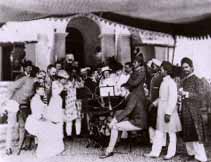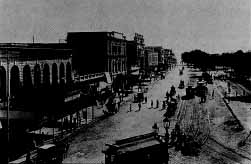The Legacy of Raja Deen Dayal’
Recently IGNCA mounted an exhibition of the photographs of Raja Lala Deen Dayal, India’s most accomplished photographer of the nineteenth century. The exhibition displayed the photographs and work equipment of Raja Deen Dayal, which are now part of IGNCA’s own collection, acquired from the family of Deen Dayal himself.
Raja Deen Dayal (1844-1905) was a professional photographer who received the patronage of the Maharaja of Indore, Lord Dufferin as well as the Nizam of Hyderabad. He was a master camera artist who has given us glimpses into his contemporary society, from the lives of Indian princes and the British raj, to those of folk and tribal people, monuments, archaeological sites, architectural heritage – in short vignettes from a cross section of the life around him. His photograph offer us vivid insights into India’s rich cultural heritage and are also valuable testimonials for historians. As a leading exponent of photography, Den Dayal was awarded many titles and honours during his time including a Royal Warrant from Queen Victoria. He also set up his own flourishing business as a photographer.
IGNCA’s exhibition, titled ‘The Legacy of Raja Deen Dayal’ was mounted from the glass plate negatives of the master photographer. The exhibition was broadly though fluidly arranged in three sections: The Place, The People and The Event. These covered respectively the physical setting, the individuals and the happenings and activities, which the photographer perceived as his raw material. The central rotunda of the exhibition was devoted to the photographer himself.
On 5 October 1993 the exhibition was inaugurated in the premises of C.V. Mess, IGNCA by Shri H.Y. Sharda Prasad. Dr. Kapila Vatsyayan welcomed the distinguished guests and presented the context of the exhibition, while Mr. T. Kasinath spoke on Raja Deen Dayal, the man and his work.
Shri Sharada Prasad’s inaugural address was an invitation to the exhibition itself. Here are some excerpts from his speech:
I am here not as a guest ‘inaugurating’ this exhibition, but as an insider inviting you to this work of a master of the art of photography. You would have noticed that I did not say ‘Indian master’ or ‘the art of photography in India’. For Raja Deen Dayal’s brilliance and achievement are such that he easily ranks among the greatest anywhere.
Who is master?
A master, to use cyclical reasoning, is one who makes masterpieces, which in turn make him a master! In literary criticism and writing on art we come across the word classic. A classic is not easy to define but it describes work of art, which has stood the judgement of at least three or four generations. There are many books, many paintings, which win instant acclaim, but, like a comet, which dazzles, their brilliance fades fast and they are forgotten tomorrow. Anybody is immortal for five minutes, as they say in our age of television.
But a classic endures. Sometimes it is neglected and unrecognized in the lifetime of its creator but later ages discover its worth. What applies to an individual classic applies to a master artist. Raja Deen Dayal had the good fortune to win praise when he was still young (The Graphic of London gave him three pages when he was only 33) and be acclaimed by successive generations – so much so that we have statements like ‘photography in Indian in the nineteenth century is just one individual – Deen Dayal’. An article on a Deen Dayal exhibition in London was titled ‘Photograph’s Peerless Patriarch’. The critic Dnyaneshwar Nadkarni described him as ‘Lensman extraordinary’. Prof. Galbraith in a foreword to a book of Deen Dayal’s photographs went as far as to say that Mahbub Ali, Nizam VI, by appointing Deen Dayal as his court photographer, ensured his own rescue…
In is not the pen or the typewritten or the word processor that produces literature, not the brush that paints. It is no the lens or the camera that takes a photograph, but the man behind it. When we speak of the camera eye, what we really mean is a photographer’s eye behind the camera. The great practitioner of photography, Edward Steichen, has said of his art: “Photography is a dynamic process giving form of ideas and explaining man to man”.
Deen Dayal explained not only people but our environment, our cultural heritage to people – his contemporaries as well as future generations. He was a great portraitist who saw into the soul of the people who faced him. He was also a great social historian, as he had great curiosity in all that happened in his time and recorded it for future generations. He had a special feel for places and their visual beauty and the atmosphere they exuded… In all that he did, Deen Dayal saw the outer world and the inner world…
Dr. Vatsyayan has already explained how the IGNCA came to acquire a substantial portion of Raja Deen Dayal’s negatives from his family. There must be hundreds more of his photographs in private collections and in museums here and abroad. I take this opportunity to appeal to these owners to share their collections with us for display in the further exhibitions of Deen Dayal’s work we shall be organizing and the series of monographs we shall be organizing and the series of monographs we propose to publish as a national homage to this great master.
[ Newsletter | List of Newsletter ]







